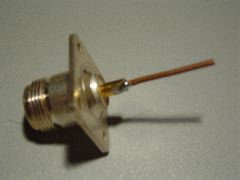
How To Build A Tin Can Waveguide WiFi Antenna for 802.11(b or g) Wireless Networks or other 2.4GHz Applications ~ by Got no dough for a commercial WiFi antenna? Looking for an inexpensive way to increase the range of your wireless network? A tin can waveguide antenna, or Cantenna, may be just the ticket. This design can be built for under $5 U.S. And reuses a food, juice, or other tin can.

This is basic instructions for handmade WiFi 5-5.8 GHz 13-14dBi Double BiQuad external antenna. Note: The dBi scale is logarithmic in base 10, where +3 dBi is a doubling in gain! An increase in gain of +1 dBi is equivalent to an increase of 26% and +2 dBi is equivalent to an increase of 60%.
I am not an electrical engineer, nor do I have access to any fancy test equipment. I’ve built some antennas that worked for me and thought I would share what I learned. I have no idea if this is safe for your radio or wireless network equipment. The risk to you and your equipment is yours. Building your Cantenna is easy, just follow these steps.
• Collect the parts • Drill or punch holes in your can to mount the probe • Assemble the probe and mount in can Collect the parts: You’ll need: • A N-Female chassis mount connector. • Four small nuts and bolts • A bit of thick wire • A can can supply the parts (the wire and can you provide yourself). The Connector A N type Female Chassis-mount connector. One side is N-female for connecting the cable from your wireless equipment, and the other side has a small brass stub for soldering on wire. Solidworks 2010 crack chomikuj filmy.
These can be found at electronics stores internet suppliers (see the list below under “Connect your antenna” If you shop around, you should be able to find these for $3-$5. Nuts & Bolts You’ll need them just long enough to go through the connector and the can.
I’ve used #6×1/4″ stainless. If your N-connector is a screw on type, then you won’t need the nuts and bolts. Wire You’ll need about 1.25″ of 12 guage copper wire.
This wire will stick into the brass stub in the N-connector. A Can This is the fun part. You’re looking for a can between about 3″ and 3 2/3″ in diameter. The size doesn’t have to be exact. I made a good antenna with a Nalley’s “Big Chunk” Beef Stew can that was 3.87″ in diameter. Others have reported good results with big 39oz.
Coffee cans that are 6″ in diameter. The pringles can is really too small for good performance, however. Try to get as long a can as possible. The old fashioned fruit juice cans should work well. Drill or punch holes in your can to mount the probe The N-connector assembly will mount in the side of your can. You need to put holes in the right place to mount the connector. The placement of the hole and connect is very important.
It’s location is derived from formulas that use the frequency that the antenna will operate at and the can diameter. Enter the diameter of your can above and click on the calculate button. 802.11b and 802.11g WiFi networking equipment operates at a range of frequencies from 2.412 GHz to 2.462 GHz. Ideally, with your can size, the TE11 cut-off frequency should be lower than 2.412 and the TM01 cut-off should be higher than 2.462. It would be good, also, if your can is longer than the 3/4 Guide Wavelength. If your can is a little off in length or diameter, don’t despair,!
You want to mark the location on the can where you will put the hole for the connector. The 1/4 Guide Wavelength number tells you how far up from the bottom metal end of the can to put the center of the hole. Open only one end of your can, eat the contents, and give it a good washing. You’ll probably want to remove the label too. Use a ruler to measure up from the closed end 1/4 Guide Wavelength and mark the can with a dot. If you’ve got a drill, select a bit that matches the size of the center of your connector.